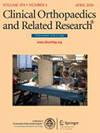Novel Hip MRI Sequence Provides Consistent Osseous Morphology Dimensions for FAI Evaluation Compared With CT.
IF 4.4
2区 医学
Q1 ORTHOPEDICS
引用次数: 0
Abstract
BACKGROUND Prior studies have reported that imaging evaluation of osseous morphology in femoroacetabular impingement (FAI) is best performed with CT, which exposes patients to ionizing radiation. In recent years, a number of studies have evaluated whether various novel MRI protocols, which do not expose patients to ionizing radiation, can effectively assess osseous morphology in patients with FAI. Our institution incorporated in- and out-of-phase sequences into a routine MRI protocol to better assess acetabular version; however, it is unknown how in- and out-of-phase MRI compares with CT imaging in FAI evaluation. QUESTIONS/PURPOSES (1) How reliably do acetabular version measurements taken from in- and out-of-phase MRI agree with acetabular version measurements taken from CT imaging? (2) How similar are hip morphometric measurements taken from routine MRI sequences as compared with hip morphometric measurements taken from hip-specific CT? METHODS We conducted a retrospective electronic medical record review of the patients of two attending sports medicine orthopaedic surgeons from May 2014 to May 2024 who were evaluated for symptomatic hips. It is the general practice of these surgeons to obtain both hip-specific CT scans and in- and out-of-phase MRI for patients with suspected FAI. Patients were included if they had a diagnosis of FAI, were older than 12 years of age, underwent hip-specific morphometric CT scanning and in- and out-of-phase MRI of the affected side, and had imaging interpretation performed by fellowship-trained musculoskeletal radiologists at our institution. Hip morphometric measurements were retrospectively recorded from prospectively interpreted radiology reports. Our initial chart review yielded 178 patients (188 hips) with a diagnosis of FAI who underwent both CT and MRI imaging. After the application of inclusion and exclusion criteria, 30 patients (33 hips) lacked an in- and out-of-phase MRI, 11 patients (11 hips) had the imaging performed on contralateral hips, and 42 patients (44 hips) lacked complete morphometric measurements, yielding 95 patients (100 hips) who were included in our study. Our study population comprised 72% (68 of 95) females with a mean ± SD age of 29 ± 9 years and BMI of 25.3 ± 4.7 kg/m2. Of those included, 56 patients had their measurements confirmed by our institution's fellowship-trained musculoskeletal radiologists to assess for intrarater and interrater reliability. The assessed morphometric measurements included: midcoronal angle, midsagittal angle, alpha angle, femoral neck angle, and femoral neck version at the 1, 2, and 3 o'clock positions. These measurements were statistically compared with intraclass correlation coefficients (ICCs) to assess intermodality measurement agreement and thus determine the reliability between in- and out-of-phase MRI and CT. Each morphometric measurement also underwent t-tests to determine the similarity in measurements between in- and out-of-phase MRI and hip-specific CT sequences. RESULTS Acetabular version measurements taken from the unique sequences of in- and out-of-phase MRI demonstrated ICCs of 0.62, 0.67, and 0.80 at 1, 2, and 3 o'clock, respectively. Other morphometric measurements with standard MRI sequencing demonstrated ICCs ranging from a low of 0.41 (poor) for femoral neck angle to a high of 0.73 (moderate) for femoral version. Higher ICCs demonstrate moderate to good agreement between imaging modalities for acetabular version measurements with unique axial sequences of in- and out-of-phase MRI and CT scans. ICC values comparing measurements from routine MRI protocol and CT scans demonstrate poor to moderate agreement in morphometric measurements between imaging modalities. This indicates a reliable agreement in morphometric measurements between in- and out-of-phase MRI and CT and less reliability in agreement for measurements made with routine MRI. CONCLUSION The in- and out-of-phase MRI protocol had moderate to good reliability in correlation to CT for evaluating acetabular version in patients with FAI. Hip osseous and soft tissue evaluation may be effectively achieved using in- and out-of-phase MRI axial sequences in addition to routine hip MRI sequences. Surgeons who perform hip arthroscopy may consider being more selective in using CT for evaluating FAI. Future research may incorporate additional MRI sequences to better evaluate FAI hip morphometric measurements. LEVEL OF EVIDENCE Level IV, diagnostic study.与CT相比,新的髋关节MRI序列为FAI评估提供了一致的骨形态尺寸。
先前的研究报道,股骨髋臼撞击(FAI)的骨形态成像评估最好使用CT,这将使患者暴露于电离辐射中。近年来,许多研究评估了各种不使患者暴露于电离辐射的新型MRI方案是否可以有效评估FAI患者的骨形态。我们的机构将同相和异相序列纳入常规MRI方案,以更好地评估髋臼病变;然而,在FAI的评估中,MRI的同相和非同相与CT的比较尚不清楚。(1)同期和非同期MRI测量的髋臼形状与CT成像测量的髋臼形状是否一致?(2)从常规MRI序列中获得的髋关节形态测量结果与从髋关节特异性CT中获得的髋关节形态测量结果有多相似?方法回顾性分析2014年5月至2024年5月期间,两名运动医学骨科医生对髋关节症状进行评估的患者的电子病历。对于疑似FAI的患者,这些外科医生的一般做法是同时进行髋关节特异性CT扫描和期内和期外MRI扫描。如果患者被诊断为FAI,年龄大于12岁,接受了髋关节特异性形态CT扫描和患侧的同期和异期MRI扫描,并由我们机构接受过培训的肌肉骨骼放射科医生进行影像学解释,则纳入研究。髋骨形态测量数据回顾性记录来自前瞻性解读的放射学报告。我们最初的图表回顾发现178例(188髋)诊断为FAI的患者接受了CT和MRI成像。应用纳入和排除标准后,30例患者(33髋)缺乏期内和期外MRI, 11例患者(11髋)在对侧髋关节进行了成像,42例患者(44髋)缺乏完整的形态测量测量,共95例患者(100髋)纳入我们的研究。我们的研究人群包括72%(95人中有68人)的女性,平均±SD年龄为29±9岁,BMI为25.3±4.7 kg/m2。其中,56名患者的测量结果由我们机构训练的肌肉骨骼放射科医生确认,以评估手术内和手术间的可靠性。评估的形态学测量包括:中冠状角、中矢状角、α角、股骨颈角和1,2,3点钟位置的股骨颈版本。这些测量结果与类内相关系数(ICCs)进行统计比较,以评估多模态测量的一致性,从而确定相内和相外MRI和CT之间的可靠性。每个形态计量学测量也进行了t检验,以确定相内和相外MRI和髋关节特异性CT序列之间测量的相似性。结果:通过独特的期内和期外MRI序列进行的髋臼版本测量显示,1,2,3点钟位置的ICCs分别为0.62,0.67和0.80。其他标准MRI测序的形态学测量显示,ICCs范围从股骨颈角低0.41(差)到股骨角高0.73(中等)。较高的icc显示髋臼版本测量的成像模式与独特的轴向序列的同相和异相MRI和CT扫描之间有中度到良好的一致性。比较常规MRI方案和CT扫描测量的ICC值表明,成像方式之间的形态测量结果一致性较差。这表明在同相和非同相MRI和CT之间的形态测量测量可靠一致,而与常规MRI测量一致的可靠性较低。结论:在评估FAI患者髋臼变形时,期内和期外MRI方案与CT相比具有中等到良好的可靠性。除了常规的髋关节MRI序列外,还可以使用相内和相外MRI轴向序列有效地评估髋关节骨和软组织。进行髋关节镜检查的外科医生可能会考虑在使用CT评估FAI时更有选择性。未来的研究可能会纳入额外的MRI序列,以更好地评估FAI髋关节形态测量。证据等级:IV级,诊断性研究。
本文章由计算机程序翻译,如有差异,请以英文原文为准。
求助全文
约1分钟内获得全文
求助全文
来源期刊
CiteScore
7.00
自引率
11.90%
发文量
722
审稿时长
2.5 months
期刊介绍:
Clinical Orthopaedics and Related Research® is a leading peer-reviewed journal devoted to the dissemination of new and important orthopaedic knowledge.
CORR® brings readers the latest clinical and basic research, along with columns, commentaries, and interviews with authors.

 求助内容:
求助内容: 应助结果提醒方式:
应助结果提醒方式:


